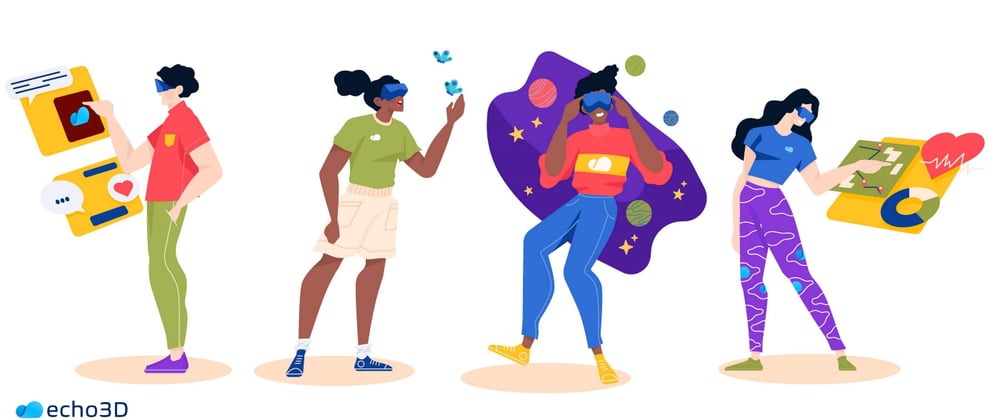The Metaverse is here, and it is here to stay. Augmented reality (AR), virtual reality (VR), NFTs, 3D gaming, Web3, blockchain all are just a few of technological trends the past few years. Many business are already preparing for the metaverse and are considering how this new virtual space affects their marketing opportunities.
We've identified at least 5 major marketing strategies for companies building their brand in the metaverse.
1. Create and Share AR filters
It is becoming standard practice for companies to utilize Snapchat and Instagram's popularity to promote their own brand with the help of AR filters for users. Brands are able to use this social platforms to create face makes, world lenses, interactive AR game lenses, AR portals, and "shoppables" which allows you to virtually try on a piece of clothing, shoes, or accessory.
Gucci is one example of a company that has done this successfully. It launched an AR lens that allowed you to try on Gucci shoes with the help of an AR Snapchat filter. ASOS also published a campaign on Instagram with AR company Lenslist with a face lens that customer could use to explore what kind of shopper they are.
2. Let customers "try before they buy"
An increasingly popular way of leveraging AR for marketing is to let your customers try your products before making a purchase. Studies show that 61% of shoppers prefer retailers who offer AR technology, while 72% of shoppers purchased items they had not planned to because of AR. This opens up many new opportunities for companies to increase their sales and convince more potential customers to more a purchase. Often, brands also allow consumers to share their different looks with their friends to increase brand engagement.
For example, Warby Parker offers a mobile application which has an AR feature that allows you to virtually try on every single model of eyeglasses and sunglasses in their store using your front-facing camera. This made it easier than ever for me to find the perfect style and fit for my face without stepping outside my house. Sephora is also leveraging AR technology to let customers virtually try makeup on to make it easier for customers to shop online.
Sounds interesting? Check out how you can create your own an AR makeup try-on tool with echo3D or even build your own virtual store.
3. Create and sell NFTs
The interest for non-fungible tokens, commonly known as NFTs, has spiked during the past year. In simple terms, an NFT is unique virtual collectible, which ownership is recorded using blockchain. This means that NFTs are not interchangeable and present new opportunities for collectors, artists, gamers, and even fashion designers (think one-of-a-kind digital artwork, trading cards, character skins, avatars, and more!). Now more and more well-known brands are joining the trend of creating their own NFTs for marketing purposes.
Taco Bell created its own NFTs that were all sold out within 30 minutes, with a resale value for some of the pieces going for up to $3,000. Nike also acquired RTFKT Studios, a virtual shoe company which makes NFTs of sneakers for the Metaverse.
Want to showcase your NFTs in AR and share them with your friends? Check this out.
4. Recreate physical products for digital avatars
Did you know that many brands digitize their physical products and sell them for customers to be used for their digital avatars? Companies such as Balenciaga have begun designing and selling virtual designer clothing for metaverse. Last year, Gucci created a VR fashion exhibit on Roblox. A virtual version of their Gucci Dionysus bag was sold for over $4,115 more than the retail price of physical purse. This strategy will likely continue to grow and is a great example of the many opportunities of marketing in the metaverse.
5. AR marketing campaigns
With the use of AR, brands can create immersive marking campaigns in the real world. There are several examples of companies that have utilized this strategy.
Taco Bell added QR codes to its packaging that made it possible to see Twitter and Facebook posts about the new product in AR in real time. Pepsi Max transformed a bus station into a AR experience in which bystanders must giant robots or notice pedestrians being abducted by flying saucers or monster tentacles rising up from the sewers. Talk about creating a buzz around your brand!
%[https://youtu.be/GB_qT6rAPyY]
Do you want to create your own web-based AR marketing campaigns?
Try using echo3D's 3D-ready cloud platform to create personalized WebAR experiences without needing to code at all. But this is just the tip of the iceberg. You can use our cross-platform system to build apps using any AR/VR client-side SDK (ARCore, ARKit, Vuforia, WebXR, AR.js, Swift, Flutter, Oculus SDK, Unity-based SDKs, Microsoft HoloLens, MagicLeap, and more).
by Emma Truve
echo3D (www.echo3D.co; Techstars'19) is a cloud platform for 3D/AR/VR that provides tools and network infrastructure to help developers & companies quickly build and deploy 3D apps, games, and content.














Oldest comments (0)